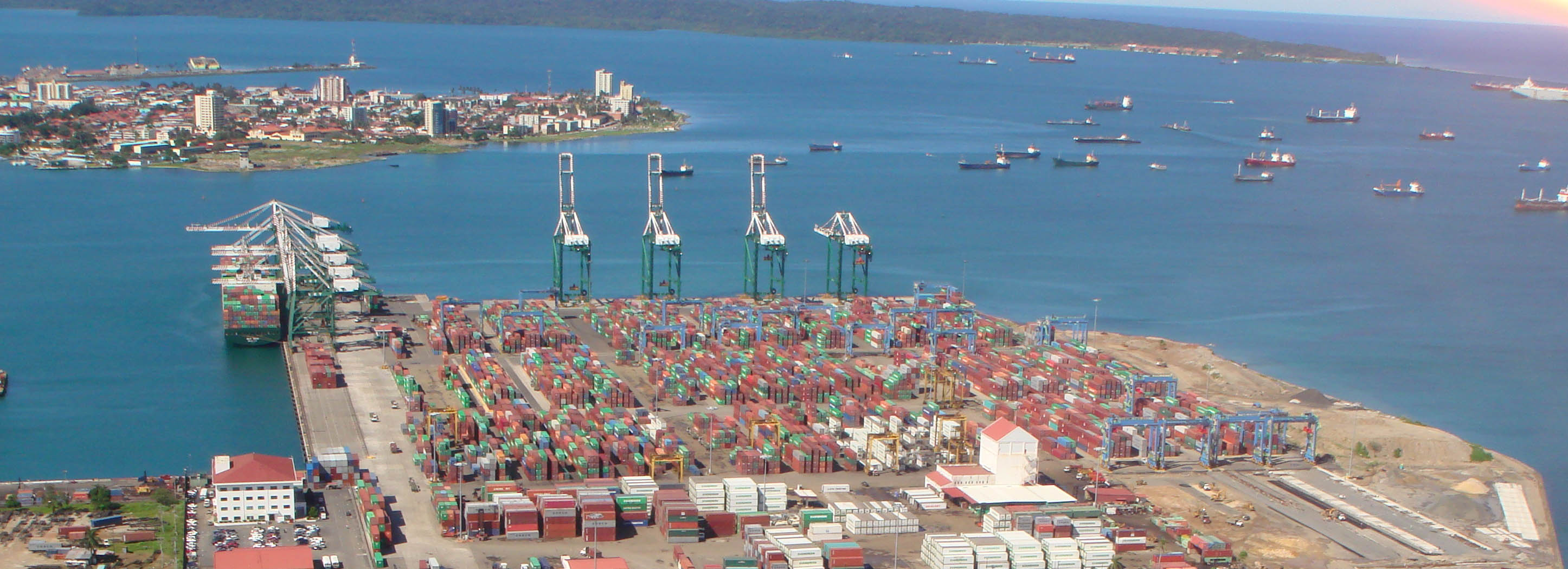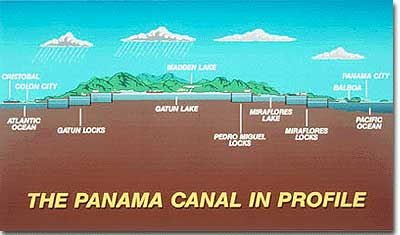The swell is not as bad as I am normally used to over here. It seems that in the last few days the strength and the angle of the wind has been slightly different than what is normal here, and as a result the swell is lower than normal and thus the ship is not rolling as much as it can do here. That different weather can happen here if there is a cold front going over Florida which did occur on February 27. Then if the tail comes low enough, the prevailing winds change and that results in less swell or a swell from another direction. It does not always happen as it depends on how the tail of such a cold front is moving over Mexico and how far south it extends. This cold front was not very nice for Florida but it works out in our favor here in the South West Caribbean as we do not have a wobbly ship.
For the guests the Panama Canal starts tomorrow morning at 05.00 hrs. when we are expected at the entrance to the Panama Canal near Cristobal. Luckily tonight we have an hour back, so everybody can have a good rest and get up early.
For the captain and the ship the Panama Canal planning starts already days earlier, with the notifications starting 96 hrs. in advance. Then an update before 48 hrs., then 24 hrs. (Sometimes also 12 hrs.) and then as soon as the ship is in VHF range, a confirmation of the arrival time. That is most of the time also the moment that the PCA (Panama Canal Authority) changes the arrival time, so you have to adjust for later or earlier. Hence a good cruise ship captain tries to build up a bit of leeway in the system so he can make 30 minutes or an hour earlier or so if needed. The multiple arrival notifications are mainly due to the fact that the canal needs to deal with cargo ships, which are not as punctual in keeping schedules as the cruise ships are. As they do not treat us any different, apart from having preference to being slotted in as soon as are there, we follow the same rules. Apart from those ETA (Estimated Time of Arrival) notifications, the ship has to send in a whole slew of certificates and other paperwork. See below at the end of the blog. Once a ship has transited once, some of this paper work, can be kept on file with the PCA and only updates are needed.
The ship has not received yet, the Final Transit schedule (and even when we get one, then we cannot always keep to it) but in general a cruise ship transit works as follows:
05.00 Christobal Breakwater
05.00 – 06.30 Clearance of the Ship, boarding on the Panama Canal Pilots
07.00 – 08.30 Near and in the Gatun Locks
If there is no delay with the opposing convoy we start our transit directly, if there is a delay we might have to anchor for an hour or so. If no delay:
11.30 -12.25 Passing Gamboa (here is where the opposing convoy’s meet so the slowest ship dictates the timing)
14.00 Pedro Miguel Locks
15.00 Miraflores Locks
17.00 Passing Balboa
17.30 Sea Buoy, end of Passage.
But this whole schedule is subject to “extremely” change, I had done the crossing in under 8 hrs. and a colleague of mine was once out at the Balboa sea buoy by 13.30, so an 8.5 hrs. transit which might well be the Holland America Line record. The other way around is also possible, I remember one crossing in my career that we went in at 05.00 hrs. and came out at 20.00 hrs. a transit of 15 hrs. courtesy of a ship ahead of us, which decided to bash into the center wall of the Gatun Locks, and refused to move until a Panama Canal and Lloyd’s Surveyor had attended. So my ship and several others all had to drop anchor and wait. The not affected side of the lock system was used by the ships coming in, as they could not wait in the Canal. No space to drop anchor.
So I hope that we will have an un-eventful crossing, with only nice events for the guests. Maybe we will see alligators or crocodiles and monkeys.
Expected Weather: Partly Cloudy 91oF / 33oC. Little wind and no rain. It is going to be a sun block 50 day with baseball caps and hats on.

One thing we will not see, or better said only the lights of it in the dark, is Cristobal at the entrance as it will still be dark. (Photo courtesy www.Clipperoilcom) What is now one big container terminal, used to be in the past five or six regular docks of the passenger and cargo ship;s
As per Panama Canal Authority: The following documentation shall be declared 96 hours prior to Panama arrival: The documents must be legible, of good quality, and shall include all pages.
Receiving this information in advance will expedite the vessel’s scheduling process, the calculations required for the proper assessment of tolls and other services, and facilitate the inspection process upon arrival. Please note that the vessel will be measured upon arrival.
- International Tonnage Certificate (ITC-69)
- PC/UMS Documentation of Total Volume or suitable substitute
- Volume calculations (If available)
- Suez Canal Certificate (If available)
- Load Line Certificate (If multiple Load Lines exist, provide the one with least freeboard)
- Pilot Card (Vessels speed and general information)
- Ship Particulars
- Certificate of Registry
- Ship Classification Certificate
- Minimum Crew Safe Manning Certificate
- International Sewage Pollution Prevention Certificate
- Passenger Ship Safety Certificate – Form P (for passenger vessels)
- Certificate of Fitness (for Chemical Tanker and Gas Carriers)
The following drawings (plans) shall be provided in PDF or AUTOCAD format only, in one plan (not sections), in order to allow for precise calculations:
- General Arrangement Plan
- Capacity Plan with deadweight scale
- Midship Section Plan
- Lines Plan (if available)
- Shell Expansion Plan
- Docking Plan
- Visibility Plan
- Trim and stability booklet or hydrostatic information (summer loaded figures at zero trim for extreme draft, displacement, deadweight and tons of immersion)
- Lightship Test Report or Result Deadweight Measurement Report (for Dry bulkers)
- Container Loading or Stowage Plan when fully loaded (full container vessels only)
- Cargo Securing Manual (full container vessels only – All pages regarding container information above and below deck and all combinations available)
- And then the passenger data information, and all that goes along with it, such as health certificates, medical statements, security licenses. etc.


March 1, 2020 at 1:10 am
Thank you for your most informative newsletters Captain. I have made 3 Panama Canal transits on HAL ships. I am curious as to the taxes and fees paid to the PCA. How are the PCA fees based and what are they for the Rotterdam or any other ship with whom you are familiar?
March 1, 2020 at 12:22 pm
Hi Captain:
We will be on the Rotterdam 10 day Caribbean on March 27. Will you still be on the Rotterdam?
March 1, 2020 at 6:37 pm
Thank you for reading my blog.
Unfortunately no. That is the day I am scheduled to leave for my next ship.
Please enjoy your cruise
Best regards
Capt. Albert
March 1, 2020 at 4:36 pm
Captain A,
The paperwork would seem to be overwhelming but my guess is it becomes routine. Who below the Captain is responsible for putting all of this together so it can be transmitted to Canal authorities in a timely manner? Is it done by your Headquarters or by ship officers–if so who?
Thanks and regards,
Roger T.
March 1, 2020 at 6:42 pm
Thank you for (still) reading my blog.
yes it is a lot of paperwork, with the cargo ships it is mainly the captain who has to deal with this, unless his office pre-submits the standard items. On the cruise ships it is partly done by the Hotel Admdinistration (port paper officer, crew purser) and partly done by the navigation team. The more transits you make the less the paperwork as the PCA does keep everything nicely on record.
Best regards
Capt. Albert
March 3, 2020 at 11:17 am
Love to read your blogs. I’ve been through the PanamaCanal three times , Twice on the Prinsendam, love to hear about the details of the ship, and such a great remembrance!